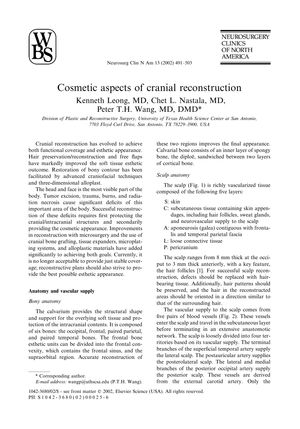Cosmetic Aspects of Cranial Reconstruction
November 2002
in “
Neurosurgery Clinics of North America
”

TLDR The article concludes that cranial reconstruction should aim for the best aesthetic result, using various techniques tailored to individual needs and conditions.
The article from November 2002 discusses advancements in cranial reconstruction, focusing on the importance of achieving both functional and aesthetic outcomes. Techniques such as hair preservation/reconstruction, the use of free flaps, and advanced craniofacial techniques have evolved to enhance the restoration of bony contour and soft tissue aesthetics. The authors stress the significance of preserving hair patterns during reconstruction and explore various alternatives for reconstruction after oncologic resection. They conclude that reconstructive plans should aim for the best possible esthetic appearance, considering factors like prior scarring and the need for postoperative radiation. Tissue expanders, muscle flaps, microvascular free flaps, fasciocutaneous flaps, osseocutaneous flaps, and the omentum flap are discussed as options for reconstruction, with the choice depending on defect specifics and the need for good vascular supply and soft tissue coverage. Alloplastic materials are highlighted for their customizability and use in well-vascularized areas, while free flap reconstruction is recommended for irradiated tissue. The document underscores the necessity of preoperative assessment and the removal and delayed reconstruction of infected bone.







